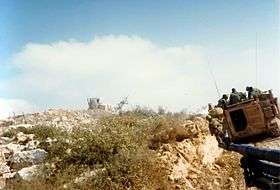South Lebanon conflict (1985–2000)
| ||||||||||||||||||||||||||||||||

The South Lebanon conflict (1985–2000) or the Security Zone conflict in Lebanon refers to 15 years of warfare between the Israel Defense Forces and its Lebanese Christian proxy militias against Lebanese Muslim guerrillas led by the Iranian-backed Hezbollah, within what was defined by Israelis as the "Security Zone" in South Lebanon.[10][11] It can also refer to the continuation of conflict in this region, beginning with the Palestine Liberation Organization (PLO) operations transfer to South Lebanon, following Black September in the Kingdom of Jordan. Historical tension between Palestinian refugees and Lebanese factions fomented the violent Lebanese internal political struggle between many different factions. In light of this, the South Lebanon conflict can be seen as a part of the Lebanese Civil War.
In earlier conflicts prior to the 1982 Israeli invasion, including Operation Litani, Israel attempted to eradicate PLO bases from Lebanon and support Christian Maronite militias. The 1982 invasion resulted in the PLO's departure from Lebanon. The creation of the Security Zone in South Lebanon benefited civilian Israelis, although at great cost to Palestinian and Lebanese civilians. Despite this Israeli success in eradicating PLO bases and its partial withdrawal in 1985, the Israeli invasion increased the severity of conflict with local Lebanese militias and resulted in the consolidation of several local Shia Muslim movements in Lebanon, including Hezbollah and Amal, from a previously unorganized guerrilla movement in the south. Over the years, military casualties of both sides grew higher, as both parties used more modern weaponry, and Hezbollah progressed in its tactics. By the early 1990s, Hezbollah, with support from Syria and Iran, emerged as the leading group and military power, monopolizing guerrilla activity in South Lebanon.
By the year 2000, following an election campaign promise, newly elected Prime Minister Ehud Barak withdrew Israeli forces from Southern Lebanon within the year,[10] in accordance with UN Security Council Resolution 425, passed in 1978; the withdrawal consequently resulted in the immediate total collapse of the South Lebanon Army.[12] The Lebanese government and Hezbollah still consider the withdrawal incomplete until Israel withdraws from Shebaa Farms. Following the withdrawal, Hezbollah has monopolized its military and civil control of the southern part of Lebanon.
Background
Following the 1948 Arab Israeli War, the 1949 Armistice Agreements were signed with United Nations mediation. The Lebanese-Israeli agreement created the armistice line, which coincided exactly with the existing international boundary between Lebanon and Palestine from the Mediterranean to the Syrian tri-point on the Hasbani River. From this tri-point on the Hasbani the boundary follows the river northward to the village of Ghajar, then northeast, forming the Lebanese-Syrian border. (The southern line from the tri-point represents the Palestine-Syria border of 1923.) Israeli forces captured and occupied 13 villages in Lebanese territory during the conflict, including parts of Marjayun, Bint Jubayl, and areas near the Litani River,[13] but withdrew following international pressure and the armistice agreement.
Although the Israel-Lebanon border remained relatively quiet, entries in the diary of Moshe Sharett point to a continued territorial interest in the area.[14] On 16 May 1954, during a joint meeting of senior officials of the defense and foreign affairs ministries, Ben Gurion raised the issue of Lebanon due to renewed tensions between Syria and Iraq, and internal trouble in Syria. Dayan expressed his enthusiastic support for entering Lebanon, occupying the necessary territory and creating a Christian regime that would ally itself with Israel. The issue was raised again in discussions at the Protocol of Sèvres.[15]
The Israeli victory in the 1967 Six Day War vastly expanded their area occupied in all neighboring countries, with the exception of Lebanon, but this extended the length of the effective Lebanon-Israel border, with the occupation of the Golan Heights. Although with a stated requirement for defense, later Israeli expansion into Lebanon under very similar terms followed the 1977 elections, which for the first time, brought the Revisionist Likud to power.[13]
Emerging Conflict between Israel and Palestinian militants
Beginning with the late 1960s and especially in the 1970s, following the defeat of PLO in Black September in Jordan, displaced Palestinians, including militants affiliated with the Palestinian Liberation Organization, began to settle in South Lebanon. The unrestrained buildup of Palestinian militia, and the large autonomy they exercised, led to the popular term "Fatahland"[16] for South Lebanon. Since the mid 1970s the tensions between the various Lebanese factions and Palestinians had exploded, resulting in Lebanese Civil War.
Following multiple attacks launched by Palestinian organizations in the 1970, which increased with the Lebanese Civil War, the Israeli government decided to take action. Desiring to break up and destroy this PLO stronghold, Israel briefly invaded Lebanon in 1978, but the results of this invasion were mixed. The PLO was pushed north of the Litani River and a buffer zone was created to keep them from returning, with the placement of the United Nations Interim Force in Lebanon (UNIFIL). In addition and despite earlier covert support, Israel established a second buffer with renegade Saad Haddad’s Christian Free Lebanon Army enclave (initially based only in the towns of Marjayoun and Qlayaa); the now-public Israeli military commitment to the Christian forces was strengthened. For the first time however, Israel received substantive adverse publicity in the world press due to damage in South Lebanon, in which some 200,000 Lebanese (mostly Shia Muslims) fled the area and ended up in the southern suburbs of Beirut; this indirectly resulted in the Syrian forces in Lebanon turning against the Christians in late June and complicated the dynamics of the on-going Lebanese Civil War.[17]
1982 Israeli invasion
In 1982, the Israeli military began "Operation Peace for Galilee",[18] a full scale invasion of Lebanese territory. The invasion followed the 1978 Litani Operation, which gave Israel possession of the territory near the Israeli-Lebanese border. This follow-up invasion attempted to weaken the PLO as a unified political and military force[19] and eventually led to the withdrawal of PLO and Syrian forces from Lebanon. By the end of this operation, Israel got control over Lebanon from Beirut southward, and attempted to install a pro-Israeli government in Beirut to sign a peace accord with it. This goal had never realized, partly because of the assassination of President Bashir Gemayel in September 1982, and the refusal of the Lebanese Parliament to endorse the accord. The withdrawal of the PLO forces in 1982 forced some Lebanese nationalists to start a resistance against the Israeli army led by the Lebanese Communist Party and Amal movement. During this time, some Amal members started the formation of an Islamic group supported by Iran that was the nucleus of the future "Islamic Resistance", and eventually become Hezbollah.
Chronology
Occupation period 1982–1985 – the emergence of Hezbollah

Increased hostilities against the US resulted in the April 1983 United States Embassy bombing. In response, the US brokered the May 17 Agreement, in an attempt to stall hostilities between Israel and Lebanon. However, this agreement eventually failed to take shape, and hostilities continued. In October, the United States Marines barracks in Beirut was bombed (usually attributed to the Islamic Resistance groups). Following this incident, the United States withdrew its military forces from Lebanon.
Suicide bombings became increasingly popular at this time, and were a major concern of the Israel Defense Forces (IDF) both near Beirut and in the South. Among the most serious were the two suicide bombings against the Israeli headquarters in Tyre, which killed 103 soldiers, border policemen, and Shin Bet agents, and also killed 49–56 Lebanese. Israel believes those acts were among the first organized actions made by Shi'ite militants, later forming into Hizbullah. Subsequently, Israel withdrew from the Shouf Mountains, but continued to occupy Lebanon south of the Awali River.
An increased number of Islamic militias began operating in South Lebanon, launching guerrilla attacks on Israeli and pro-Israel militia positions. Israeli forces often responded with increased security measures and airstrikes on militant positions, and casualties on all sides steadily climbed. In a vacuum left with eradication of PLO, the disorganized Islamic militants in South Lebanon began to consolidate. The emerging Hezbollah, soon to become the preeminent Islamic militia, evolved during this period. However, scholars disagree as to when Hezbollah came to be regarded as a distinct entity. Over time, a number of Shi’a group members were slowly assimilated into the organization, such as Islamic Jihad members, Organization of the Oppressed on Earth, and the Revolutionary Justice Organization.
Israeli withdrawal to Security Zone

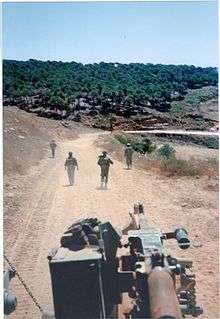
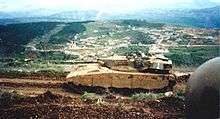
In February 1985, Israel withdrew from Sidon and turned it over to the Lebanese Army, but faced attacks: 15 Israelis were killed and 105 wounded during the withdrawal. Dozens of SLA members were also assassinated. From mid-February to mid-March, the Israelis lost 18 dead and 35 wounded. On 11 March, Israeli forces raided the town of Zrariyah, killing 40 Amal fighters and capturing a large stock of arms. On 9 April, a Shiite girl drove a car bomb into an IDF convoy, and the following day, a soldier was killed by a land mine. During that same period, Israeli forces killed 80 Lebanese guerrillas in five weeks. Another 1,800 Shi'as were taken as prisoners. Israel withdrew from the Bekaa valley on 24 April, and from Tyre on the 29th, but continued to occupy a security zone in Southern Lebanon.

In 1985 Hezbollah released an open letter to "The Downtrodden in Lebanon and in the World", which stated that the world was divided between the oppressed and the oppressors. The oppressors were named to be mainly the United States and Israel. This letter legitimized and praised the use of violence against the enemies of Islam, mainly the West. The newfound unity among these Shi'a armed groups in 1985 has been credited to the disappearance of Musa al-Sadr. Fighting the Israeli occupation included hit-and-run guerrilla attacks, suicide bombings, and the Katyusha rocket attacks on civilian targets in Northern Israel, including Kiryat Shmona. The Katyusha proved to be an effective weapon and became a mainstay of Hezbollah military capabilities in South Lebanon. The attacks resulted in both military and civilian casualties. However, a considerable number of Lebanese guerillas were killed fighting Israeli and SLA troops, and many were captured. Prisoners were often detained in Israeli military prisons, or by the SLA in the Khiam detention center, where detainees were often tortured. Lebanese prisoners in Israel were arrested and detained for participating in guerrilla movements, and many were held for long periods of time.
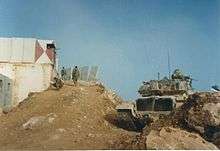
In 1987 Hizbullah fighters from the Islamic Resistance stormed and conquered an outpost in Bra’shit belonging to the South Lebanon Army in the security zone. A number of its defenders were killed or taken prisoner and the Hizbullah flag was raised on top of it. A Sherman tank was blown up and a M113 Armored Personal Carrier was captured and driven triumphantly all the way to Beirut.[20]
In May 1988, Israel launched an offensive codenamed Operation Law and Order in which 1,500-2,000 Israeli soldiers raided the area around the Lebanese village of Maidun. In two days of fighting, the IDF killed 50 Hizbullah fighters while losing 3 dead and 17 wounded.[21]
After Israel destroyed Hezbollah's headquarters in the town of Marrakeh, a Hezbollah suicide bomber destroyed an Israeli transport truck carrying soldiers on the Israel-Lebanon border. In response, Israeli forces ambushed two Hezbollah vehicles, killing eight Hezbollah fighters.[22]
On 28 July 1989, Israeli commandos captured Sheikh Abdul Karim Obeid, the leader of Hezbollah. This action led to the adoption of United Nations Security Council Resolution 638, which condemned all hostage takings by all sides.[23][24]
Taif Accord
The Lebanese Civil War officially came to an end with the 1989 Ta'if Accord, but the armed combat continued at least until October 1990,[19] and in South Lebanon until at least 1991.[25] In fact, the continued Israeli presence in South Lebanon resulted in continued low-intensity warfare and sporadic major combat until the Israeli withdrawal in 2000.
Post Civil War conflict
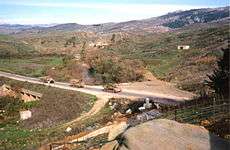



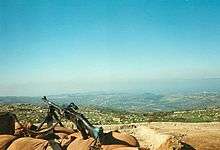
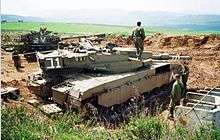
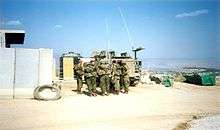
Though the majority of the Lebanese civil war conflicts ended in the months following the Ta'if Accord, Israel kept maintaining a military presence in South Lebanon. Consequently, the Islamic Resistance, by now dominated by Hezbollah, continued operations in the South. On 16 February 1992, Hezbollah leader Abbas al-Musawi was killed along with his wife, son and four others when Israeli AH-64 Apache helicopter gunships fired three missiles at his motorcade. The Israeli attack came in retaliation for the killings of three Israeli soldiers two days earlier when their camp was infiltrated. Hezbollah responded with rocket fire onto the Israeli security zone, and Israel then fired back and sent two armored columns past the security zone to hit Hezbollah strongholds in Kafra and Yater.[26] Musawi was succeeded by Hassan Nasrallah. One of Nasrallah's first public declarations was the "retribution" policy: If Israel hit Lebanese civilian targets, then Hezbollah would retaliate with attacks on Israeli territory.[19] Meanwhile, Hezbollah continued attacks against IDF targets within occupied Lebanese territory. In response to the attack, Ehud Sadan, the chief of security at the Israeli Embassy in Turkey was assassinated by a car bomb.[27]
In 1993, hostilities flared again. After a month of Hezbollah shelling on Israeli towns and attacks on its soldiers, Israel conducted a seven-day operation in July 1993 called Operation Accountability in order to hit Hezbollah. One Israeli soldier and 8–50 Hezbollah fighters were killed in the operation, along with 2 Israeli and 118 Lebanese civilians. After one week of fighting in South Lebanon, a mutual agreement mediated by the United States prohibited attacks on civilian targets by both parts.[28]
The end of Operation Accountability saw a few days of calm before light shelling resumed. On August 17, a major artillery exchange took place, and two days later, nine Israeli soldiers were killed in two Hezbollah attacks. Israel responded with airstrikes against Hezbollah positions, killing at least two Hezbollah fighters.[29]
Continued hostility in late 1990s
In May 1994, Israeli commandos kidnapped an Amal leader, Mustafa Dirani, and in June, an Israeli airstrike against a training camp killed 30–45 Hezbollah cadets. Hezbollah retaliated by firing four barrages of Katyusha rockets into northern Israel.[30][31]
Brig. Gen. Eli Amitai, the IDF commander of the security zone, was lightly injured 14 December 1996 when an IDF convoy he was travelling in was ambushed in the eastern sector of the security zone.[32] Less than a week later Amitai was again lightly injured when Hezbollah unleashed a mortar barrage on an SLA position near Bra'shit he was visiting together with Maj. Gen. Amiram Levine, head of the IDF's Northern Command.[33]
Operation Grapes of Wrath in 1996 resulted in the deaths of more than 150 civilians and refugees, most of them in the shelling of a United Nations base at Qana. Within a few days, a ceasefire was agreed between Israel and Hezbollah, committing to avoid civilian casualties; however, combat continued for at least two months. A total of 14 Hezbollah fighters, about a dozen Syrian soldiers, and 3 Israeli soldiers were killed in the fighting.
In December 1996, two SLA soldiers were killed in three days of fighting, and a Hezbollah fighter was also killed by Israeli soldiers.[34]
On 4 February 1997, two Israeli transport helicopters collided over She'ar Yashuv in Northern Israel while waiting for clearance to fly into Lebanon. A total of 73 IDF soldiers were killed in the disaster. On 28 February one Israeli soldier and four Hezbollah guerrillas were killed in a clash.[35]
Throughout 1997, Israeli special forces, particularly the Egoz Reconnaissance Unit, hampered Hezbollah's ability to infiltrate the security zone and plant roadside bombs by staking out Hezbollah infiltration trails. Encouraged by these successes, Israeli commandos began conducting raids north of the security zone to kill Hezbollah commanders. In one particular raid, carried out on the night of August 3–4, 1997, Golani Brigade soldiers raided the village of Kfour and left behind three roadside bombs packed with ball bearings that were detonated from an Israeli Air Force UAV hours later, killing five Hezbollah members including two commanders. However, on August 28, a major friendly fire incident occurred in Wadi Saluki during a clash between IDF troops from the Golani Brigade, together with air and artillery support, and Amal militants. Although four Amal militants were killed, Israeli shelling started a fire that engulfed the area, killing four soldiers.[36]
On 5 September 1997, a raid by 16 Israeli Shayetet 13 naval commandos failed after the troops stumbled into a Hezbollah and Amal ambush. As the force headed towards it's target, it was ambushed with IEDs and subjected to withering fire that killed the commander, Lt. Col. Yossi Korakin, and caused bombs being carried by another soldier to explode, killing more of the force. The survivors radioed for help, and Israel immediately dispatched a rescue team from Unit 669 and Sayeret Matkal in two CH-53 helicopters. A rescue force of helicopters and missile boats arrived to provide support as the rescuers evacuated the dead and survivors, conducting airstrikes. Lebanese Army anti-aircraft units put up anti aircraft fire and fired illumination rounds at the helicopters, and an Israeli F-16 subsequently attacked an anti-aircraft position. Hezbollah put up mortar fire, killing a doctor with the rescue force and damaging a helicopter and Israeli missile boats fired at the source of the mortar fire. The battle ended when Israel, by means of contacting the US government and delivering a message to be passed on to Syria and from there to Hezbollah, threatened to respond with massive force if Hezbollah tried to stop the rescue mission, causing Hezbollah and Amal to cease fire while the Lebanese Army moved in. Twelve Israelis were killed, along with six Hezbollah and Amal fighters and two Lebanese soldiers. In 2010 Hassan Nasrallah claimed that Hezbollah had managed to hack into Israeli UAV:s flying over Lebanon and thus learn which route the commandos were planning to take and thus prepared the ambush accordingly.[37][38] On September 13–14, IDF raids in Lebanon killed a further four Hezbollah fighters and six Lebanese soldiers.[39]
On September 12, 1997, three Hezbollah fighters were killed in an ambush by Egoz commandos on the edge of the security zone. One of them was Hadi Nasrallah, the son of Hezbollah leader Hassan Nasrallah. On 25 May 1998 the remains of Staff Sergeant Ilya were exchanged for 65 Lebanese prisoners and the bodies of 40 Hezbollah fighters and Lebanese soldiers captured by Israel.[40] Among the bodies returned to Lebanon were the remains of Hadi Nasrallah.
During 1998, 21 Israeli soldiers were killed in southern Lebanon. Israel undertook a concerted campaign to hamper Hezbollah's capabilities, and on 2 December 1998, the Israeli military assassinated Zahi Naim Hadr Ahmed Mahabi, a Hezbollah explosives expert, north of Baalbek.[41]
23 February 1999 an IDF paratrooper unit on a night time patrol was ambushed in south Lebanon. Major Eitan Balahsan and two lieutenants were killed and another five soldiers were wounded.[42][43]
Less than a week later (28 February) a roadside bomb exploded on the road between Kfar Ka’urkabeh and Arnoun in the Israeli-occupied security zone. Brigadier General Erez Gerstein, commander of the Golani Brigade and head of the IDF Liaison Unit in Lebanon, thus the highest ranking Israeli officer serving in Lebanon at the time, as well as two Druze Israeli soldiers and one Israeli journalist were killed in the blast.[44]
In May 1999 Hizbullah forces simultaneously attacked 14 Israeli and SLA outposts in south Lebanon. The outpost in Beit Yahoun compound belonging to the SLA was overrun and one SLA soldier was taken prisoner. The Hizbullah fighters made off with an Armoured Personnel Carrier (APC). The area was bombed by the Israeli Air Force.[45] The captured APC was paraded through the southern suburbs of Beirut.[46]
In one notable battle, Hezbollah saboteurs surprised an IDF force from the Golani Brigade stationed in an old fort. Two Israeli soldiers and three Hezbollah fighters were killed.
In August 1999, Hezbollah commander Ali Hassan Deeb, better known as Abu Hassan, a leader in Hezbollah's special force, was assassinated in an Israeli military operation. Deeb was driving in Sidon when two roadside bombs were detonated by a remote signal from a UAV overhead.[47][48]
Overall, in the course of 1999, several dozen Hezbollah and Amal fighters were killed. Twelve Israeli soldiers and one civilian were also killed, one of them in accident.[49]
In February 2000, Colonel Aql Hashem, the SLA western brigade commander that was a leading candidate to succeed General Antoine Lahad, was killed in the blast.
2000: Israeli withdrawal
In July 1999, Ehud Barak became Israel's Prime Minister, promising Israel would unilaterally withdraw to the international border by July 2000. Prior to his actions, many believed that Israel would only withdraw from South Lebanon upon reaching an agreement with Syria.
In January 2000, Hezbollah assassinated the commander of the South Lebanon Army's Western Brigade, Colonel Aql Hashem, at his home in the security zone. Hashem had been responsible for day-to-day operations of the SLA.[50][51][52] After this assassination there were doubts about the leadership of the South Lebanon Army (SLA). The pursuit and assassination of Hashim was documented step by step and the footage was broadcast on Hezbollah TV channel al-Manar. The operation and the way it was presented in media dealt a devastating blow to the morale in the SLA.[53]
During the spring of 2000, Hezbollah operations stepped up considerably, with persistent harassment of Israeli military outposts in occupied Lebanese territory. As preparation for the major withdrawal plan, Israeli forces began abandoning several forward positions within the security zone of South Lebanon. On 24 May, Israel announced that it would withdraw all troops from South Lebanon. All Israeli forces had withdrawn from Lebanon by the end of the next day, more than six weeks before its stated deadline of 7 July.[54]
The Israeli pullout resulted in the collapse of the SLA and the rapid advance of Hezbollah forces into the area. As the Israeli Defense Forces (IDF) withdrew, thousands of Shi'a Lebanese rushed back to the South to reclaim their properties. This withdrawal was widely considered a victory for Hezbollah and boosted its popularity in Lebanon. The completeness of the withdrawal is still disputed as Lebanese Government and Hezbollah claim Israel still holds Shebaa farms, a small piece of territory on the Lebanon-Israel-Syria border, with disputed sovereignty.
As a Syrian-backed Lebanese government refused to demarcate its border with Israel, Israel worked with UN cartographers led by regional coordinator Terje Rød-Larsen to certify Israel had withdrawn from all occupied Lebanese territory. On 16 June 2000, UN Security Council concluded that Israel had indeed withdrawn its forces from all of Lebanon, in accordance with United Nations Security Council Resolution 425 (1978).
Israel considered this move as tactical withdrawal since it always regarded the Security Zone as a buffer zone to defend Israel's citizens. By ending the occupation, Barak's cabinet assumed it would improve its worldwide image. Ehud Barak has argued that "Hezbollah would have enjoyed international legitimacy in their struggle against a foreign occupier", if the Israelis had not unilaterally withdrawn without a peace agreement.[55]
Aftermath
Upon Israel's withdrawal, an increasing fear that Hezbollah would seek vengeance against those thought to have supported Israel became widespread among the Christian Lebanese of the Southern Lebanon. During and after the withdrawal around 10,000 Lebanese, mostly Maronites, fled into Galilee. Hezbollah later met with Lebanese Christian clerics to reassure them that the Israeli withdrawal was a victory for Lebanon as a nation, not just one sect or militia.[19]
The tentative peace, resulting from the withdrawal, did not last. On 7 October 2000 Hezbollah attacked Israel. In a cross-border raid, three Israeli soldiers, who were patrolling the Lebanese border were attacked and abducted. The event escalated into a 2-month fire exchanges between Israel and Hezbollah, primarily at the Hermon ridge. The bodies of the abducted soldiers were returned to Israel in a January 2004 prisoner exchange involving 450 Lebanese prisoners held in Israeli jails. The long-time Lebanese prisoner Samir al-Quntar was excluded from the deal. The government of Israel, however, had agreed to a "further arrangement", whereby Israel would release Samir al-Quntar if it was supplied with "tangible information on the fate of captive navigator Ron Arad".[56]
According to Harel and Issacharoff the second phase of the prisoner exchange deal was only a "legal gimmick". Israel was not satisfied with the information supplied by Hezbollah and refused to release al-Quntar. "Cynics may well ask whether it was worth getting entangled in the Second Lebanon War just to keep Kuntar […] in prison for an extra few years."[57]
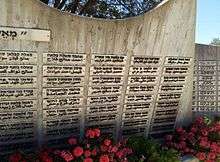
In July 2006, Hezbollah performed a cross-border raid while shelling Israeli towns and villages. During the raid Hezbollah succeeded in kidnapping two Israeli soldiers and killing eight others. In retaliation Israel began the 2006 Lebanon War to rescue the abducted soldiers and to create a bufferzone in Southern Lebanon.[58][59][60][61]
See also
- Syrian occupation of Lebanon
- Army of the Guardians of the Islamic Revolution
- 2008 conflict in Lebanon
- List of modern conflicts in the Middle East
Notes
- ↑ Helmer, Daniel Isaac. Flipside of the Coin: Israel's Lebanese Incursion Between 1982-2000. DIANE Publishing, 2010.
- ↑ "2000: Hezbollah celebrates Israeli retreat". BBC News. May 26, 2000. Retrieved July 25, 2006.
- ↑
- "Land for Peace Timeline". British-Israeli Communications & Research Centre. 2006. Retrieved 25 January 2011.
- "The Israeli Withdrawal from Southern Lebanon". The American-Israeli Cooperative Enterprise. 2011. Retrieved 25 January 2011.
- "Hezbollah 101: Who is the militant group, and what does it want?". Christian Science Monitor. 19 July 2012. Retrieved 4 October 2012.
Iran has also played an instrumental role in building up Hezbollah's military capabilities over the years, which enabled the group's impressive military wing to oust Israel from south Lebanon in 2000
- 1 2 3 4 Gal Luft. "Israel's Security Zone in Lebanon - A Tragedy?". Middle East Forum. Retrieved 6 February 2015.
- ↑ 657 killed from 1982-1985 (Wars, Internal Conflicts, and Political Order: A Jewish Democracy in the Middle East, Gad Barzilai, pp. 148), 1,216 killed from 1982-2000 (Imperfect Compromise: A New Consensus Among Israelis and Palestinians, Michael I. Karpin) = 559 killed 1985-2000
- ↑ "SOUTH OF LEBANON- SOUTH LEBANON ARMY". Retrieved 6 February 2015.
- 1 2 "In the Path of Hezbollah". Ahmad Nizar Hamzeh. Retrieved 7 July 2015.
- ↑ A Hezbollah recruiting drive covers its losses and deeper involvement inside Syria
- ↑ Luft, Gal. "Israel's Security Zone in Lebanon - A Tragedy?" Middle East Quarterly, September 2000, 13-20.
- 1 2 Online NewsHour: Final Pullout – May 24, 2000 (Transcript). "Israelis evacuate southern Lebanon after 22 years of occupation." Retrieved 15 August 2009.
- ↑ Hezbollah makes explosive return: Israel's proxy militia under fire in south Lebanon. Charles Richards, The Independent. 18 August 1993. Retrieved 15 August 2009.
- ↑ UN Press Release SC/6878. (18 June 2000). Security Council Endorses Secretary-General's Conclusion On Israeli Withdrawal From Lebanon As Of 16 June.
- 1 2 Naseer H. Aruri, Preface to the 3rd(?) edition, Israel’s Sacred Terrorism, Livia Rokach, Association of Arab-American University Graduates, ISBN 978-0-937694-70-1
- ↑ Livia Rokach, Israel’s Sacred Terrorism, Association of Arab-American University Graduates, ISBN 978-0-937694-70-1
- ↑ Avi Shlaim, The Protocol of Sèvres,1956: Anatomy of a War Plot, International Affairs, 73:3 (1997), 509–530
- ↑ Urban Operations: An Historical Casebook. "Siege of Beirut", by George W. Gawrych. US Army Combat Studies Institute, Fort Leavenworth, KS. 2 October 2002. Available at globalsecurity.org.
- ↑ Major George C. Solley, The Israeli Experience in Lebanon, 1982–1985, US Marine Corps Command and Staff College, Marine Corps Development and Education Command, Quantico, Virginia. 10 May 1987. Available from GlobalSecurity.org
- ↑ 1982 Lebanon Invasion. BBC News.
- 1 2 3 4 Norton, Augustus Richard; Journal of Palestine, 2000
- ↑ Blanford, Nicholas, Warriors of God - Inside Hezbollah's Thirty-Year Struggle Against Israel, Random House, New York, 2011, pp. 85-86
- ↑ Journal of Palestine Studies. Volume XVII No 3 (67) Spring 1988. ISSN 0377-919X. Page 221. Chronology complied by Katherine M. LaRiviere
- ↑ Ross, Michael The Volunteer: The Incredible True Story of an Israeli Spy on the Trail of International Terrorists (2006)
- ↑ UN Security Council (31 July 1989). "The Question of Hostage-Taking and Abduction" (PDF). Security Council Resolutions, 1989. United Nations. Retrieved 25 January 2011. External link in
|work=(help) - ↑ UN Resolution 638, reprinted by Jewish Virtual Library
- ↑ Tension grows in South Lebanon as Israel bombs guerrilla targets. New York Times, 8 November 1991.
- ↑ Time Magazine: Vengeance is Mine (2 March 1992)
- ↑ http://www.nytimes.com/1992/03/08/world/car-bomb-kills-an-israeli-embassy-aide-in-turkey.html
- ↑ John Pike (30 July 2006). "Operation Accountability". Global Security. Retrieved 25 January 2011.
- ↑ http://articles.latimes.com/1993-08-20/news/mn-25732_1_israeli-soldiers
- ↑ Clyde Haberman (3 June 1994). "Dozens Are Killed As Israelis Attack Camp in Lebanon". New York Times. Retrieved 25 January 2011.
- ↑ Haberman, Clyde (3 June 1994). "Dozens Are Killed As Israelis Attack Camp in Lebanon". The New York Times.
- ↑ Naomi Segal (16 December 1996). "Fighting Erupts in Lebanon After Rockets Hit Jewish State". JTA. Retrieved 2011-11-10.
- ↑ Naomi Segal (20 December 1996). "Senior IDF Officer Wounded on Visit to Southern Lebanon". JTA. Retrieved 2011-11-10.
- ↑ http://www.aparchive.com/metadata/youtube/c2fcea9abdeb7373dcf286bdd429f344
- ↑ "Israeli Soldier, 4 Guerrillas Die in Lebanon Clash". Los Angeles Times. 1 March 1997.
- ↑ http://articles.latimes.com/1997/aug/29/news/mn-27055
- ↑ yaakov lappin (08/11/2010). "Nasrallah recalls '97 Shayetet to 'deflect pressure'". Retrieved 3 July 2013. Check date values in:
|date=(help) - ↑ Blanford, p. 190-192
- ↑ Survey of Arab-Israeli Relations, p. 232
- ↑ "Background on Israeli POWs and MIAs". MFA. Retrieved 4 December 2011.
- ↑ "Israel Kills Hezbollah Bomb Expert". Los Angeles Times. 2 January 1999. Retrieved 19 January 2012.
- ↑ deborah sontag (24 February 1999). "Israel Mourns More War Dead in Lebanon". New York Times. Retrieved 3 July 2013.
- ↑ Nicholas Blanford (24 February 1999). "3 Israelis killed in Hizbullah ambush". The Daily Star. Retrieved 3 July 2013.
- ↑ "Lebanon Liaison Unit Commander Killed in Security Zone Explosion". Globes. 1 March 1999. Retrieved 25 August 2016.
- ↑ Nicholas Blanford (17 May 1999). "Hizbullah overruns SLA post, makes off with APC". The Daily Star. Retrieved 3 July 2013.
- ↑ Sally Farhat (18 May 1999). "Hizbullah parades captured APC". The Daily Star. Retrieved 3 July 2013.
- ↑ unknown (17 May 1999). "Israel Blamed in Fatal Bomb Attack on a Hezbollah Leader". Los Angeles Times. Retrieved 17 August 2013.
- ↑ Blanford, p. 204
- ↑ "jewishvirtualibrary.org". Retrieved 6 February 2015.
- ↑ Lebanon Country Assessment. United Kingdom Home Office, October 2001.
- ↑ Kamil Jabir (2007-07-29). "خالد بزي (قاسم) يكتب ملحمة بنت جبيل (Khalid Bazzi (Qasim) writes the Bint Jbeil epic)". al-Akhbar. Retrieved 3 January 2012.
- ↑ Blanford, pp. 243-244
- ↑ Harb, Zahera, Channels of Resistance in Lebanon - Liberation Propaganda, Hezbollah and the Media, I.B. Tauris, London-New York, 2011, pp.214-216
- ↑ Country Profile: Lebanon Timeline, BBC News.
- ↑ Camp David and After: An Exchange. (An Interview with Ehud Barak). New York Review of Books, Volume 49, Number 10. 13 June 2002. Retrieved online, 15 August 2009.
- ↑ "Government statement on prisoner exchange". MFA. 24 January 2004. Retrieved 4 December 2011.
- ↑ Avi Issacharoff and Amos Harel (19 October 2007). "Closing the Arad file?". Retrieved 14 December 2011.
- ↑ Margaret Hall, American Myopia: American Policy on Hizbollah. The Muslim World: Questions of Policy and Politics. Cornell University undergraduate research symposium. 8 April 2006.
- ↑ "...Hezbollah enjoys enormous popularity in Lebanon, especially in southern Lebanon...", Ted Koppel on NPR report: Lebanon's Hezbollah Ties. All Things Considered, 13 July 2006.
- ↑ BBC: "On This Day, May 26th".
- ↑ CNN report: Hezbollah flag raised as Israeli troops withdraw from southern Lebanon. 24 May 2000.
